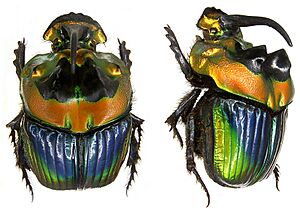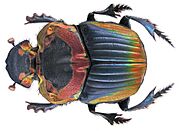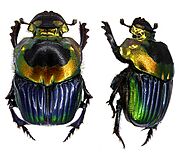Sulcophanaeus imperator facts for kids
Quick facts for kids Sulcophanaeus imperator |
|
|---|---|
 |
|
| Male Sulcophanaeus i. imperator | |
| Scientific classification | |
| Kingdom: | |
| Phylum: | |
| Class: | |
| Order: | |
| Family: | |
| Genus: |
Sulcophanaeus
|
| Species: |
S. imperator
|
| Binomial name | |
| Sulcophanaeus imperator (Chevrolat, 1844)
|
|
| Synonyms | |
|
|
The Sulcophanaeus imperator is a very colorful type of dung beetle. It belongs to a group of beetles called Scarabaeidae. This beetle is active during the day, which means it is diurnal.
It is also a coprophagous beetle, meaning it eats dung. These beetles are found in south-central South America and are quite common. They are paracoprid beetles. This means the adult beetles dig tunnels under their food source. They then move parts of the food into a special nest chamber where they lay their eggs.
Contents
Where Do These Beetles Live?
You can find Sulcophanaeus imperator beetles in parts of Argentina, Bolivia, and Paraguay. They like to live in dry places. These include thorny forests, open pastures, and scrublands. They can be found from about 300 meters (about 1,000 feet) to 3,000 meters (about 10,000 feet) above sea level.
Different Kinds of Sulcophanaeus imperator
There are three main types, or subspecies, of this beetle. Sometimes, people think of them as different color forms instead of separate subspecies.
- Sulcophanaeus imperator imperator (also called the "golden phase") – This type is found widely in central and northern Argentina, and in Paraguay.
- Sulcophanaeus imperator alticollis (the "red phase") – This type lives in the highlands of Bolivia and northern Argentina.
- Sulcophanaeus imperator obscurus (the "green phase") – This type is only known from La Rioja, Argentina.
What Do They Look Like?
Adult Sulcophanaeus imperator beetles are about 18 to 28 millimeters long. That's about the length of your thumb! Male beetles have a long, dark, and curved horn on their forehead. Female beetles usually have only a very small bump where the horn would be.
The three different types (or color phases) of this beetle look very similar, except for their colors. All of them have a black center on their head. They also have a large black spot on the middle part of their body, called the pronotum. The front and middle parts of their wing covers, called the elytra, are shiny blue, shiny green, or black.
- In the "golden phase" (S. i. imperator), the outer parts of the head and the outer and back parts of the pronotum are gold or coppery. They often have some shiny green too. The back part and outer edges of their wing covers are also gold, coppery, or shiny green.
- In the "red phase" (S. i. alticollis), the outer parts of the head, the outer and back parts of the pronotum, and the back part and outer edges of the wing covers are shiny coppery red to brick red.
- In the "green phase" (S. i. obscurus), the outer parts of the head, the outer and back parts of the pronotum, and the back part and outer edges of the wing covers are shiny green.
Images for kids



